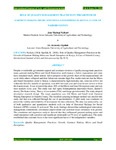| dc.description.abstract | Despite considerable government support and assistance in terms of quality management practices many garment making Micro and Small Enterprises performance is below expectation and some have remained small, others indeed fail to progress to the growth phase of the organizational life cycle while others collapsed and their failure rate remains high. Past studies indicate that the Micro and Small Enterprises sector in Kenya is characterized by high mortality rate, three out of five fail within the first few months of operation, over 60% fail each year and most do not survive to their third anniversary. It was reported that about 20% of the Micro and Small Enterprises enter and exit most markets every year. This study was built upon Schumpeterian innovation theory, Kanter’s theory, The Kano theory, Theory of constraints (TOC) and Stage growth model. The study adopted descriptive research design. The target population was 810 Micro and Small Scale Garment Making Enterprises in Nairobi County. The stratified sampling technique method was used for this study and data was collected through the use of questionnaires. A pilot study was conducted to pretest the validity and reliability of instruments for data collection. The data was analyzed by use of both qualitative and quantitative methods with the help of Statistical Package for Social Sciences (SPSS) version 21 and excel. The study findings showed that technological innovation, management commitment, continuous improvement and customer focus influences firm growth. The correlation and regression analysis showed that they influenced garment making micro and small enterprises with a positive and significant relationship at 5% level of significance. The study established that customer focus is the most significant factor of the independent variables. | en_US |

